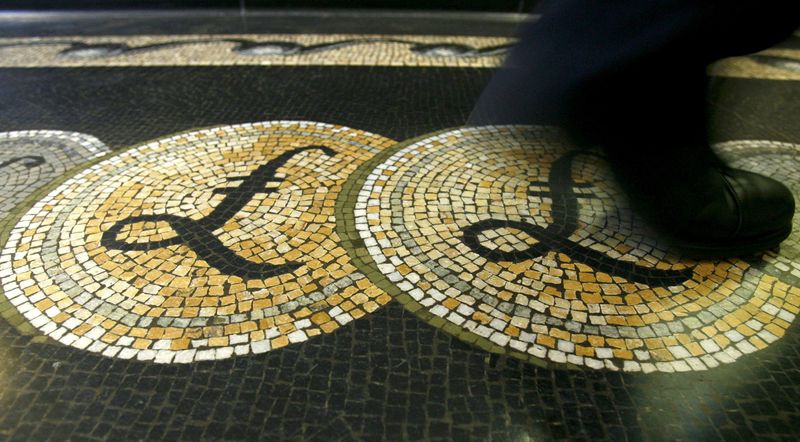By Mike Dolan
LONDON (Reuters) - Sterling's been down so long, this looks like up to most people.
Against the dark mood surrounding the British economy and dour positioning on the pound over the past 18 months, spring appears brighter - even if the gloomy weather being endured by anyone living in the country might suggest otherwise.
As with most western economies, 2023 in Britain has been fiendishly difficult year to parse so far.
Doggedly double-digit inflation twinned with rising interest rates, labour strikes and fear of recession has intertwined with significant energy price relief for households and government and a steadier political footing than seen during the chaos of last September.
A mixed bag that can go either way, some might argue.
And yet relative to such low expectations and clawback related to the UK's disproportionate exposure to now ebbing natural gas prices, the year appears to have taken an unexpectedly positive twist.
And while few envy the job of the Bank of England - meeting again this week - the economic fillip allows it some additional space to finally get across stubborn if lagged inflation and the long-shunned pound is lapping that up.
With a wry nod to the weekend coronation of King Charles, Goldman Sachs (NYSE:GS)' currency team labelled an upgrade of its sterling recommendation from neutral to 'Long (live) Sterling' - nudging a 3-month forecast for sterling 3% stronger to 0.86 per euro.
The essence of the message was simple - the surprise factor was on the pound's side. "Headwinds on sterling in 2022 - mostly natural gas prices and the relative stance of BoE policy - have turned to tailwinds."
Judged by high frequency economic data, that surprise been pretty dramatic.
Economic surprise indexes compiled by Citi show incoming UK readouts more positive relative to expectations than at any time since October 2020. Strikingly, that's happened as equivalent euro indexes have plunged into negative territory for the first time since September and even U.S. and global gauges have ebbed.
And even though there was a modest pullback last week, Goldman's bullish switch reflected CFTC data that shows the first net long position in sterling among speculative traders since before the Ukraine invasion almost 15 months ago.
And there's something happening under the bonnet of the equity market as well.
"What's fascinating this year is how the FTSE 250 has caught up with the FTSE 100 and that's some reflection of the domestic story and how the UK has simply performed stronger than expected," said Dawn Li Wan Po, senior portfolio manager at Julius Baer.
The FTSE 100 of UK-based blue chips - loaded as it is with big cap energy, mining and pharmaceuticals companies more geared to commodity prices or global economic trends - outperformed the domestically facing FTSE 250 mid-caps by more than 20% last year.
But the FTSE 250 is mostly holding its own so far in 2023 as they have both advanced 3%-4%. And evening up those scales owes something to the rising pound.
GRAPHIC - Bank of England's rate trajectory
https://www.reuters.com/graphics/GLOBAL-MARKET/THEMES/zdvxdjbwlvx/chart.png
GRAPHIC - BoE's inflation woes
https://www.reuters.com/graphics/BRITAIN-BOE/movakyyabva/chart.png
GRAPHIC - Pound Positioning and Positive Surprises
https://fingfx.thomsonreuters.com/gfx/mkt/zdvxdgegjvx/Two.PNG
JUST ONE RELUCTANT HIKER
Measured by the BOE's trade-weighted sterling index, the pound is at its strongest of the year - up more than 8% from the depths of September's budget blowup and gilt crisis. It's at its highest in more than a year against the dollar and strongest since December on the euro.
All of which will be a relief for the BoE as it prepares another quarter point rate rise to 4.5% on Thursday - only matching last week's modest increases by the Federal Reserve and European Central Bank despite fears of the stickiness of 10%-plus UK inflation and anxiety about housing market vulnerability to a 12th straight hike in 17 months.
Critical for the pound is whether the BoE thinks the nasty inflation surprises are now behind it and whether the early year gas price swoon now kicks in earnest. Can it be as equivocal as the Fed on the need for more hikes or emphasise more to come just like the ECB did last week.
DWS economist Katrin Loehken thinks that, like the euro zone, Britain probably did make it through the winter without a recession - despite unprecedented declines in real incomes.
But she added: "Interest rate hikes are only reaching the broad economy with a significant delay. This means that the BoE will continue to act in a very data-dependent manner."
For money markets, the BOE's implied terminal rate is now as high as 4.9% by November - implying three more quarter point hikes in store - three more than futures pencil in for the Fed and at least one more than the ECB is expected to execute.
Piecing it altogether, that would mean UK policy rates would be almost 30 basis points above U.S. equivalents by yearend and 130bp above ECB rates - both the biggest margins since 2008.
Do BoE chief Andrew Bailey and team really have that sort of leeway without cratering the surprising economic optimism that's offering them the very window to keep tightening?
For Goldman's strategists, the relative central bank stance has at least evened up a bit.
"Even if the BoE remains in the 'reluctant hiker' camp, most other G10 central banks have now joined that group as well - so the case for divergence is less clear," Goldman Sachs told clients.
That's hardly a ringing endorsement in itself. But after the past year, any endorsement of the pound resonates.
GRAPHIC - UK Economic Surprises surge vs rest of the west
https://fingfx.thomsonreuters.com/gfx/mkt/znpnbmgmmpl/Three.PNG
GRAPHIC - G3 Terminal Rates
https://fingfx.thomsonreuters.com/gfx/mkt/jnvwyrorovw/Four.PNG
GRAPHIC - FTSE100 vs FTSE250

https://fingfx.thomsonreuters.com/gfx/mkt/gkvlwkekjpb/One.PNG
The opinions expressed here are those of the author, a columnist for Reuters.
(by Mike Dolan, Twitter: @reutersMikeD; Editing by Lisa Shumaker)